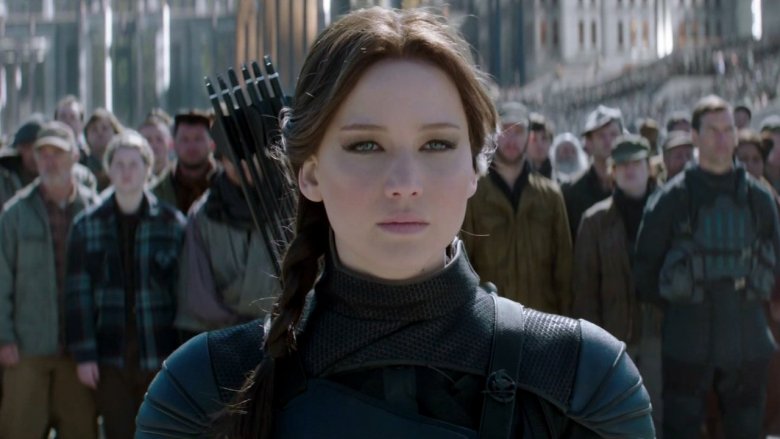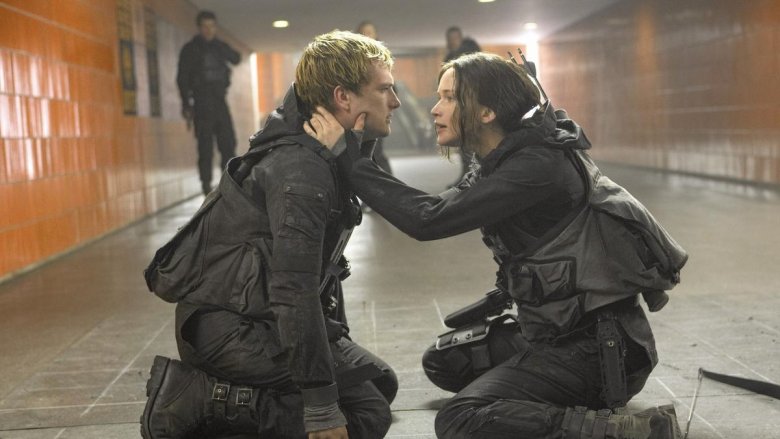

Even before Suzanne Collins' The Hunger Games trilogy became a blockbuster film franchise that catapulted Jennifer Lawrence's career to the next level, the books produced ravenous fanfare. Mockingjay, the final installment, was a hotly anticipated novel that sold nearly half a million copies in its first week alone. But the big finish had a lot of ground to cover—the culmination of a revolution, the aftermath of toppling a tyrannical dictatorship, and, of course, Katniss Everdeen's ultimate decision between dual love interests Gale Hawthorne and Peeta Mellark. With so much in motion for Mockingjay, you might've missed something in The Hunger Games' big finish, so here's a rundown of the Girl on Fire's last fight.

By the end of Catching Fire, the Resistance was beginning to heat up in some of the districts, with even a few of the victors teaming up to defy the Capitol and run recon during the Quarter Quell. But there was a heavy price to be paid for such public disobedience, and District 12 was wiped off the face of Panem before Mockingjay began. Thanks to Plutarch Heavensbee's secret scheme with Johanna Mason and Finnick Odair, Katniss was successfully rescued from the Arena and transported to District 13 which was—surprise!—a real place that survived underground despite the Capitol's insistence that the weapons district had been destroyed.
Its leader, Alma Coin, managed to establish communications with the Resistance leaders in other districts and, thanks to some propos produced with Katniss as the face of the revolution, what began as a spark became a full-on inferno of backlash against Snow and his peacekeepers. With the benefit of the numbers and District 13's massive stockade of weapons, the Resistance eventually dismantled the Capitol's most important stronghold, District 2, which left the Capitol wide open for eventual invasion.
Such sophisticated militarism on the part of the rebels was a new development, as prior attempts at uprising had been unsuccessful. But the Capitol tried to sweep a looming power under the rug by vanquishing District 13 from public memory by way of its state-run media, and they learned the hard way that the oppressed don't stay down forever.

The Arena for the 75th Annual Hunger Games was destroyed by Beetee's lightning rod retrofitting in Catching Fire, which meant that the Games were done. That didn't mean Snow was quite done making a spectacle of violent deaths just yet, though.
Coin sent Katniss and her so-called Star Squad—including a brainwashed Peeta who wanted nothing more than to kill his former partner-slash-love interest—to a supposedly safe portion of the city to film more pump videos for the other rebels. But once Commander Boggs was killed in action, she was left in charge of the squad and decided to proceed to President Snow's mansion with or without their help. This meant going underground in an effort to avoid the litany of surveillance cameras and traps planted throughout the city, but they did not find safety and comfort below ground either. Snow's grisly muttations also found them there and took out the newlywed father-to-be Finnick Odair.
This development was buckling to behold because it meant that there was no escape from Snow's lecherous love of violence. Because his sinister death traps were no longer contained to the Arenas, they couldn't be considered just entertaining avenues of punishing the districts for their historical uprising anymore; they meant that Snow and his ilk were insatiably bloodthirsty and didn't mind how close to home their nefarious tactics hit. Not even Snow's own backyard was exempt from using extraordinarily grisly devices to take down his enemies.

With all of the mental manipulation that was done to Peeta while in Capitol captivity, it looked like Katniss' choice between her tribute-turned-victor and childhood confidante Gale would be easy. One was still partially convinced he must kill her and the other stood at her side, ready to die for her. But Gale made a grave mistake that would forever hinder his relationship with Katniss.
Back at District 13, he'd aligned with Beetee and others to design bombing devices that would ensure maximum impact—one explosion, followed by another that might eliminate any of the unharmed who'd into assess the damage from the first. That tactic was ghastly enough on its own, but as Katniss finally managed to make way to Snow's mansion gates, the weapon became especially gruesome to witness in action.
Snow summoned all of the Capitol's children to the gates, promising to bring them in for safekeeping, but the parachuted bombs dropped on the heads of those innocent safety-seekers. Katniss' little sister Prim rushed in with the rest of the medic crew and succumbed to the secondary explosion. For that, Katniss would always blame Gale. Not only did that effectively end any chance of a romantic relationship between them, but it showed Katniss (and audiences) that even allies can be cruel just for the sake of it—that the notion of a good guy-bad guy divide is never quite as simple as it seems.

Amidst the gate side explosions, Katniss was severely burned and needed intensive care to recover from her injuries. Once she regained consciousness, the Resistance had completed their mission to infiltrate the mansion. President Snow was a prisoner of war, and Coin was finally running the place. But Snow wasn't quite done having his way.
Katniss was granted permission to speak with Snow in his rose garden, and he informed her then that those bombs weren't the Capitol's creation and that, further, Coin was merely going to be another version of himself. Sure enough, Coin's first act as interim President was to assemble the victors for a vote on whether to submit the Capitol leader's children to their own version of a Hunger Games for vengeance's sake. Katniss voted yes to the referendum but asked that she be allowed to execute Snow in trade for affirmative vote, a contingency that Coin was agreeable to.
Coin was fooled by Katniss' falsely positive vote in part because she'd been blinded by her own thirst for vengeance (and probably figured that Katniss, who'd been thrust into the Games twice herself, would be more than happy to see Capitol children made to pay for that). The other reason Katniss' pledge of support for the new Games was accepted by Coin was that she underestimated Katniss' sense of character and refusal to, as Peeta once put it, "become another piece in their Games." Katniss, meanwhile, was really playing the long game.

Because Coin was evidently one for sinister pageantry, she decided to make Snow's execution public. So, Katniss, armed with her bow, was all set to carry out Snow's death sentence in front of the whole of Panem. But with Snow's words about Coin in mind, and the knowledge that the incoming president planned to be just as cruel as the last, she assassinated Coin instead, with the intention to take her nightlock suicide pill soon after. Katniss knew her reasons for killing Coin would be unknown to most of the public and that she'd be tried as a traitor, but she was willing to trade her own life to ensure the vicious Hunger Games never happened again.
Her self-demise attempt was thwarted by Peeta, who'd started to decipher "real" from "not real" when it came to their shared history, and she was instead jailed for the murder of Coin. In the book, she was later acquitted on account of insanity. In the movie, new President Paylor, formerly a central commander of the Resistance, quietly pardoned her for the crime. Meanwhile, Snow was killed in the riotous melee that ensued after Katniss' assassination of Coin.
Did Snow play Katniss one last time? Yes. But there was also some of the same willful defiance of the Games contained in her action, too. Just like the first time those nightlock berries came into play, when she and Peeta held them up together to deny the Capitol a victor in the first round, she wasn't going to submit herself to the spectacle of such a public trial and execution as the ravenous public would invariably want. Luckily, she still managed to escape the media spectacle thanks to the mercy of the incoming administration.

Although she'd live out her days as an exile of Panem, relegated to the remains of District 12, Katniss' story ended on a bittersweet note. In the epilogue, she and Peeta learned to regain their trust for one another—although he still suffered from flashes of PTSD and often questioned her whether a given emotion or memory was true. And although Katniss had decided in her youth not to ever bear children due to the oppression of Snow's government, she and Peeta had begotten two kids, a boy and a girl, in peacetime.
By then, 20 years had passed since that fateful reaping that set everything into motion, and Katniss was encouraged by the fact that the Games were history and that her children would never face that sort of bloodsport the way their parents had. Just like families have continued to grow in even the worst of real-life circumstances, the appearance of new peace gave Katniss the sense of solace she needed to bring new life into a (hopefully) bettering world. But she and Peeta both bore the mental and physical scars of their trials forevermore.
The message was simple: peace does not come easily for those who've fought to achieve it. Just like foot soldiers who might make it back from a war physically unscathed, the mind never really leaves behind what happened, and what/who was lost, on the battlefield. That was a very important plot point for the author to make, since the emotional iconography of the Team Peeta/Team Gale-chanting fanbase might have overshadowed her underlying anti-violence statement if things had been too cozy for these two in the end.

Suzanne Collins' inspiration for The Hunger Games famously derived from flipping channels between footage of the Iraq War and TV game shows, as she started cooking up a disturbing connection between the concept of brutality and entertainment. And while Mockingjay certainly stepped away from the sportliness aspect by doing away with the Hunger Games as a central locale for the action, the relationship between political propaganda and the public was still a large factor in the story.
The concept that extreme violence could become such a readily consumed source of entertainment like this was certainly nothing new. But the manner through which her mandatory state-run media screenings became so weaponized by the government was a novel narrative that has continued to be relevant. Even as the culmination of her series commenced in a new, on-the-ground format, the use of propos and videoed violence by both sides was certainly an intentionally common thread that strung these three books and four films together. As the stakes of The Hunger Games escalated into a full-on civil war, the modality and mood of coverage remained alarmingly disconnected.
The takeaway for readers and viewers was to try and see past the two-dimensional portrayal of so much hunger, enslavement, bloodshed, and strife and to truly empathize with those people who are suffering from and fighting back against such tyranny right there on your screens.